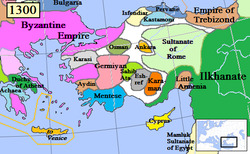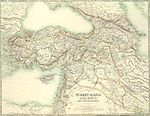Germiyanids
Germiyan | |||||||||
|---|---|---|---|---|---|---|---|---|---|
| 1300–1429 | |||||||||
 Beylik of Germiyan (light red) in 1300. | |||||||||
| Capital | Kütahya | ||||||||
| Common languages | Old Anatolian Turkish | ||||||||
| Religion | Muslim | ||||||||
| Government | Monarchy | ||||||||
| Bey | |||||||||
• 1300–1340 | Yaʿqūb I | ||||||||
• 1340–1361 | Muḥammad Chakhshādan | ||||||||
• 1361–1387 | Sulaymān Shāh | ||||||||
• 1387–1429 | Yaʿqūb II | ||||||||
| Historical era | Late Medieval | ||||||||
• Established | 1300 | ||||||||
• Disestablished | 1429 | ||||||||
| |||||||||
The Germiyanids (Old Anatolian Turkish: كرميان; Turkish: Germiyanoğulları Beyliği or Germiyan Beyliği) was a prominent Anatolian beylik established by the Oghuz Turkish tribes[1] (probably the Afshar tribe)[2] after the decline of Sultanate of Rûm. However, while the beylik was always mentioned as Turkoman or Oghuz Turkish, the population consisted of Turks and Yezidi Kurds, brought by the Seljuks from the east of Malatya to western Anatolia as militia guards against the threatening Turkish tribesmen.[3][4][5][6][7]
Origins
According to Agoston and Masters Germiyanoğulları were Turkomans who had immigrated to the west because of Mongol pressure in the second half of the 13th century.[8] The Germiyanids were of Afshar branch of Oghuz Turks.[9] Germiyanids likely came from Kerman or Fars Province, perhaps headed west with Khwarazmshahs. After the death of Jalal ad-Din Mingburnu, they remailed in Malatya area for a while, then moved to Kütahya, where they established the beylik.[9]
According to Middle East historian Petry, the Germiyans were a Turco-Kurdish dynasty.[6] However, cultural historian Cemal Kafadar states the ethnic makeup of the dynasty is too complex for a simple straightforward interpretation.[10]
History
For a brief period in the second half of the 14th century, Germiyan Dynasty was second only to Karamanid Dynasty in its rising power. But they were later taken over by the neighboring Osmanoğlu dynasty, who were to found the Ottoman Empire later.
Germiyans played a crucial role in settling Turkish populations along the coastal regions of the Aegean Sea, the founders of the Beyliks of Aydin, Sarukhan, İnançoğlu and Menteşe having started out as Germiyan commanders.
They rebelled against the central power in 1283, upon the execution of the sultan Kaykhusraw III by the Mongols, and placing of Mesud II on the Seljuq throne. The struggle between combined Mongol-Seljuq forces based in Konya and the rebel forces of Germiyan continued until 1290. An agreement could only be reached in 1299, upon which the Germiyan Dynasty also entered into possession of Ankara. When the Ilkhanid governor Emir Çoban took over Anatolia in 1314, they declared allegiance and concentrated on raids towards the regions to their west.
Their western offshoots that were the Beyliks of Menteşe, Aydin, Ladik, Sarukhan and Karasi were all subject to the Germiyan in the early periods of their foundation, while the Beyliks of Sâhib Ata and Hamidids to the south had to rely on them for protection against attacks from the Karamanids. As for the northern regions of Anatolia, Byzantine sources record Umur Bey, a commander and son-in-law to the Germiyan family, to be the possessor of Paphlagonia, where Jandarid dynasty was to rule only after Germiyan power weakened.
Their strong political entity was eventually surrounded by newer states established by their own former commanders, leaving the Germiyan no outlet to the coastline or to Byzantine territory. Their powerful Karamanid neighbors exerting constant pressure from the east, Germiyan gradually fell under the rising influence of the Ottomans. Bayezid I married with Sultan Hatun, a Germiyanid princess, and acquired the eastern portion of Germiyan as a concession in order to border the Ottoman rival, the Karamanids.[11]

Legacy
The actual Turkish province of Kütahya was called the sub-province (sanjak) and later province (vilayet) of Germiyan until the early years of the Republic of Turkey, when it was renamed after its central town.
The founding dynasty of the beylik produced illustrious descendants either under the Ottoman Empire or in present-day Turkey, a notable one among these being the 19th century grand vizier Abdurrahman Nureddin Pasha.
The Egyptian National Library and Archives keeps a copy of Qabus-Nama in Old Anatolian Turkish, written during the reign of Süleyman of Germiyan.[12]
Part of a series on the | ||||||||||||||||||||||||||||||||||||||||||
|---|---|---|---|---|---|---|---|---|---|---|---|---|---|---|---|---|---|---|---|---|---|---|---|---|---|---|---|---|---|---|---|---|---|---|---|---|---|---|---|---|---|---|
| History of Turkey | ||||||||||||||||||||||||||||||||||||||||||
 | ||||||||||||||||||||||||||||||||||||||||||
| ||||||||||||||||||||||||||||||||||||||||||
| ||||||||||||||||||||||||||||||||||||||||||
| ||||||||||||||||||||||||||||||||||||||||||
| ||||||||||||||||||||||||||||||||||||||||||
| ||||||||||||||||||||||||||||||||||||||||||
| ||||||||||||||||||||||||||||||||||||||||||
| Timeline | ||||||||||||||||||||||||||||||||||||||||||
 Turkey portal Turkey portal | ||||||||||||||||||||||||||||||||||||||||||
|
References
- ^ İnalcık, Halil (1993). The Middle East and the Balkans under the Ottoman Empire : essays on economy and society. Bloomington: Indiana University Turkish Studies. p. 97. ISBN 9781878318046.
- ^ Leiser, Gary; Koprulu, Fuat (1992). Origins of the Ottoman Empire. p. 37. ISBN 9781438410432.
- ^ Ducas, Harry J. Magoulias, Ducas, 1975 , Decline and fall of Byzantium to the Ottoman Turks, p. 265, Wayne State University Press, University of Virginia ISBN 0-8143-1540-2, ISBN 978-0-8143-1540-8, The Germiyan were probably Kurdish and Turkish half-breeds who came from east of Malatya.
- ^ Peter Malcolm Holt, 1986, The Age of the Crusades: the Near East from the eleventh century to 1517, p. 176, Longman, University of Michigan, ISBN 0-582-49303-X, 9780582493032 The second of the eastern principalities, Germiyan, developed from a group, probably of mixed Kurdish and Turkish origin
- ^ Marios Philippides, Biblioteca apostolica vaticana - 1990, Byzantium, Europe, and the early Ottoman sultans, 1373-1513: an anonymous Greek chronicle of the seventeenth century, p. 6, A.D. Caratzas, University of Michigan, ISBN 0-89241-430-8, ISBN 978-0-89241-430-7, Near Byzantine borders in Phrygia, the emirate of Germiyan was formed by a mixed population of Turks and Kurds, who had come from east of Malatya
- ^ a b Carl F. Petry, 1998, The Cambridge History of Egypt, Vol. 1, p. 527, Cambridge University Press ISBN 0-521-63313-3, ISBN 978-0-521-63313-0, An Anatolian Turco-Kurdish dynasty, with its capital at Kutahya
- ^ Bruinessen, Martin van (1992). Agha, Shaikh and State: The Social and Political Structures of Kurdistan. Bloomsbury Academic. p. 161. ISBN 978-1-85649-018-4.
- ^ Gabor Agoston-Bruce Masters, Encyclopaedia of the Ottoman Empire, p. 41 ISBN 978-0-8160-6259-1
- ^ a b Mehmet Fuat Köprülü, (1937), The Origins of the Ottoman Empire, p. 37
- ^ Kafadar 2007, p. 22.
- ^ Shaw, Stanford J. History of the Ottoman Empire and Modern Turkey: Volume 1, Empire of the Gazis: The Rise and Decline of the Ottoman Empire 1280-1808. Cambridge University Press. p. 21.
- ^ Sadettin Buluç (1969). "Eski Anadolu Türkçesiyle Bir Kabus-name Çevirisi". Belleten (in Turkish). Turkish Language Association. p. 195.
Bibliography
- Bosworth, Clifford Edmund (1996). New Islamic Dynasties: A Chronological and Genealogical Manual. Edinburgh University Press.
- Kafadar, Cemal (2007). "A Rome of One's Own: Reflections on Cultural Geography and Identity in the Lands of Rum". Muqarnas. 24. Brill: 7–25.
- (limited preview) Mehmet Fuat Köprülü (1992). The Origins of the Ottoman Empire. Translated by Gary Leiser. State University of New York Press. ISBN 0-7914-0819-1.
- Varlık, Mustafa Çetin (1996). "Germiyanoğulları". TDV Encyclopedia of Islam, Vol. 14 (Geli̇bolu – Haddesenâ) (in Turkish). Istanbul: Turkiye Diyanet Foundation, Centre for Islamic Studies. pp. 33–35. ISBN 978-975-389-441-8.












